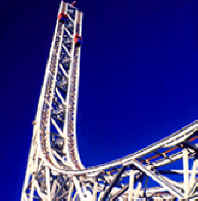|
| |
The Mechanics of Roller Coasters
|
Background
|
|
|
September 2001
|
| The first design element for
most coasters is a large hill. The cars are
pulled to the top by way of a motor that links to the
cars. The
work done by the motor is transfer to the cars as
potential energy. The
potential energy gained by the cars must be sufficient to
sustain the motion of the cars around the remainder of the
track. Designers
must ensure that the coaster cars have sufficient kinetic
energy to complete the various elements of the ride. If you go through
the loop to loop to slowly and donít accelerate downward
fast enough you will fall.
Roller coasters have no engines. Essentially a roller coaster is a gravity-powered train. The movement of a
roller coaster is accomplished by the conversion of
potential energy to kinetic energy. The roller coaster
cars gain potential energy as they are pulled to the top
of the first hill.
As the cars descend the potential energy is
converted to kinetic energy. The coaster cars have the
maximum kinetic energy they will ever have throughout the
ride. Since kinetic energy is related to speed the coaster
cars have reached maximum speed as well. The remainder of
the ride depends on the conversion of kinetic and
potential energy. Rushing
up hills the energy is converted to potential energy,
while zooming down the other side the energy is converted
back to kinetic energy.
Loss of energy due to friction and air
resistance must also be considered. Analysis of
coaster motion can be made easier if we ignore friction,
but in real coaster design all relevant forces must be
considered in order to create a safe and exciting ride for
amusement park enthusiasts.
The energy loss during each energy conversion means
that each successive hill must be lower than the last. At some point the
coaster cars will have lost so much of there original
energy the ride must end.
Amusement parks are big business. Roller coaster
designers are always striving to create larger and more
thrilling rides to keep their patrons coming back. At 415
feet high, the Superman ride at Six Flags Magic Mountain
in California is the tallest and fastest amusement park
ride in the world and features 6 seconds of weightlessness
for riders. The other unique feature of this coaster is the method by
which it supplies kinetic energy to the coaster cars. Rather than pulling the cars up a steep hill, the Superman
coaster pushes the cars using the repulsive forces created
by a set of electromagnets as a source of energy. The result is the
same, the potential energy from the magnetic system is
transferred and transformed into the kinetic energy of the
coaster cars.
Links
http://www.learner.org/
Beware
wild rides and slam dunking
http://www.sciencedaily.com
|
|
|
|

The Cyclone continues to thrill riders in the new
millennium and is the last of a long list of wooden coasters
that operated at Coney Island. Ultimate
Rollercoaster.com

Design
your own thrilling coaster at Funderstanding
Roller Coaster

The
Superman Ride at Six
Flags, California |
|
|
|